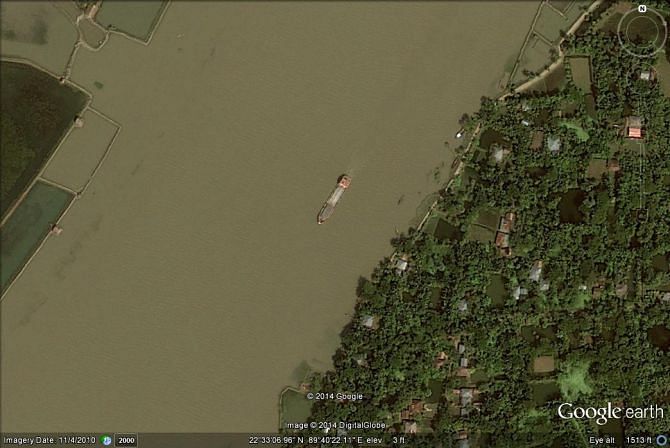Hurdles in opening Mongla-Ghashiakhali Route
Hurdles in opening Mongla-Ghashiakhali Route
PRIME Minister Sheikh Hasina has asked for closure of all shrimp farms so that the Ghasiakhali channel from the Mongla port could be reopened (bdnews24.com, Dec 15). Her directive had been awaited since the accident occurred on December 9. The 'OT Southern Star 7' sank in the Sela River and spilled 357,664 litres of furnace oil on the waters around the Sundarbans. The Sundarbans, located in the southwestern part of Bangladesh, is the largest single block of tidal halophytic (salt water tolerant) mangrove forest in the world. It lies on the mouth of the Ganges River where it is crisscrossed by hundreds of small and medium tidal creeks. The rivers passing through it are the distributaries of the Ganges, which fall into the Bay of Bengal. The oil spill has caused damage, ranging from Tk. 1,000 crore to Tk. 5,000 crore, to the environment and the economy that depends on the Sundarbans.

The Sundarbans has been subject to aggression since 1980s, while its Indian side was being developed as a wildlife sanctuary and tourist spot. Corruption in the Forest Department and failure of the Tourism Department in Bangladesh allowed such activities to be carried out. By 2000, people were protesting against it under the banner of NGOs for saving wild animals. A few years back we saw an all-out drive by the government, supported by some private parties, to vote for Sundarbans and Cox's Bazar to be included among the seven natural wonders of the world. People from all walks of life eagerly joined the campaign.
Work started in January 2010 for a coal fired power plant in Rampal of Bagerhat District. It is located very near to the Sundarbans. The environmentalists of this country objected to this plant, saying it would damage the Sundarbans through toxic gas emissions; evict people from their agricultural lands and destroy the local ecosystems, but would not give proportionate benefits against the damages that would be done. The environmentalists also demanded measures to stop dumping of oil and other wastes from the ships and vessels plying through the rivers and creeks of the Sundarbans, and from the industries in the districts surrounding the Sundarbans. But the drive to grab as much as land as possible around the Sundarbans had already started by then, with the support of political masters. BIWTA ordered closure of the Mongla Ghasiakhali navigation route in 2011, and diverted the ships to ply through the Sela River of Sundarbans.
The accident should be an eye opener for the responsible authorities, as to the nature and scale of any disaster. It took six days for the government to react, may be because of strong opposition from the Shipping Minister Mr. Shajahan Khan against closure of the the Sela River navigation route (BIWTA is under this ministry). The oil spill had by that time spread over 100 km area, affecting open fisheries, animals, birds and plants (334 species of plants and 269 species of animals live in the Sundarbans). These effects may last for decades.
Now it has become imperative to open the Ghasiakhali route as quickly as possible, but it will not be easy. This 22 km route was formally opened in November 1973. The BIWTA chairman said at the opening ceremony of the dredging of Ghasiakhali Cut in July 2014 that this route was never dredged during last 40 years. He said that after dredging, it will need about Tk. 25 crore annually for the maintenance dredging. But the Google satellite picture shows that ships were plying through the route in 2010, but it silted up by 2013. Why wasn't dredging started before the situation deteriorated? The prime minister blamed the BNP government for not maintaining the Mongla Port (bdnews24.com). But who closed the route in 2011 to give green signal to the perpetrators to grab lands for shrimp farming along the river? The prime minister has ordered removal of the shrimp farms to reopen the route. Why was a firm engaged at that time to prepare a study report, but not take up the dredging works? Was it a plan in connivance with the BIWTA officials to kill the Ghasiakhali navigation route and grab lands there and around the Sundarbans?
The BIWTA chairman said that a Chinese company was appointed for dredging Ghasiakhali Route to remove 32 lakh cubic meters of silt at the cost of Tk. 88 crore (The Daily Star 13.12.2014). Are they working according to the specifications and maintaining progress as per agreement? If the prime minister of Bangladesh wants to open the route, we believe it will be done despite many other hurdles.
The writer is Chairman, Institute of Water & Environment.
Email: minamul@gmail.com